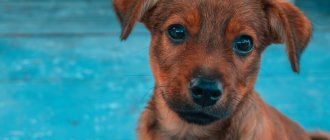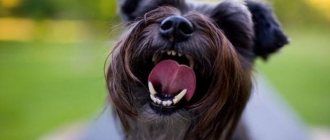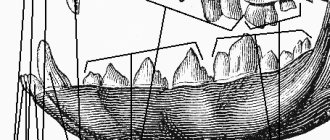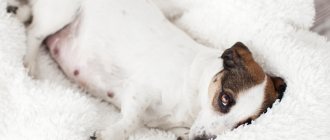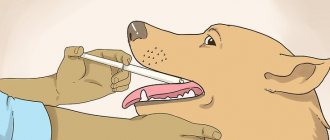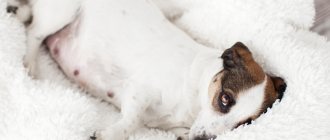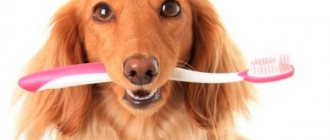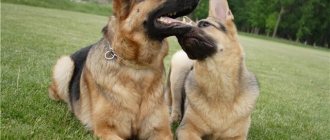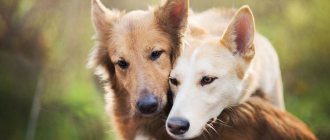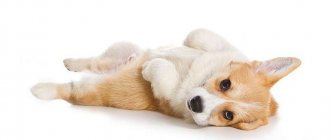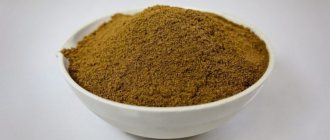Just like in children, dogs change their milk teeth to permanent teeth, with only one difference - by the age of one year the puppy turns into an adult dog. Most physiological processes, including the change of teeth in dogs, proceed at an accelerated rate.
Dog puppies are born with no teeth in the mouth - with bare gums - and by adulthood they have 42 permanent teeth.
During their lifetime, dogs have two sets of teeth - milk and permanent. Moreover, regardless of the dog’s breed, the replacement of milk teeth with permanent ones occurs in the same sequence; the only difference is in the timing of the change of teeth. There is such a pattern - in dogs of large breeds, unlike dogs of small breeds, the change of milk teeth to permanent teeth occurs faster.
Milk teeth in puppies
The development of a puppy’s dentition is a long process, accompanied by serious stress for the body. Proper bite and teeth growth plays a key role in a dog's health throughout its life. The process of teeth formation and eruption is divided into stages that the owner needs to monitor.
You've probably noticed that puppies' milk teeth are very sharp. What is the reason? Many people believe that the reason for sharp teeth is obvious - the puppy must be able to tear and chew meat. Research by zoologists has shown that there are two more equally important reasons: natural weaning from mother's milk and the acquisition of skills to control the clenching of the jaws during a bite.
The mother feeds the puppies exclusively with milk until they are one month old, after which the babies begin to develop sharp teeth. Causing discomfort to the mother, babies are increasingly denied milk when they want to suckle and are forced to look for other sources of food. During play, puppies bite. Because their teeth are very sharp, strong clenching of the jaws leads to conflict situations and interference from the mother.
The role of teeth in the life of an animal
The dental system of dogs is the main device for the primary mechanical processing of food; its importance is difficult to overestimate. It is adapted for cutting meat like scissors. All breeds, without exception, have sharp and large fangs that are saber-shaped to tear food or prey into pieces.
We recommend this article:
How many teeth should dogs have at different ages?
Cheek molars are necessary for quickly cutting food and gnawing bones. They have a triangular shape and a jagged end that resembles a blade. Premolars are used for tearing and grinding. The incisors are used for biting. Dogs use their front incisors to perform various auxiliary actions, such as catching fleas.
Symptoms of the onset of teeth change
At approximately 8 weeks of age, the puppy begins to shed its baby teeth. This period may be slightly delayed if the puppy is a large breed. Loose teeth occur because the molar tooth pushes against the baby tooth.
This is interesting! Most owners do not notice the key point in changing teeth. The baby tooth becomes loose and then simply “disappears.” Most often, the tooth falls out and is swallowed by the puppy while eating.
Symptoms of the onset of tooth loss can vary greatly. In many ways, the clinical picture depends on the dog’s temperament. Signs indicating a change in baby teeth usually appear as follows:
- Restlessness, whining, slight apathy.
- The puppy often rubs its muzzle with its paws.
- Poor appetite.
- Slight increase in temperature.
- Drowsiness.
- Diarrhea that does not lead to dehydration.
- The desire to chew and gnaw any objects.
- Resistance when trying to examine the mouth or feel the teeth.
- Smell from the mouth.
Normally, a puppy’s teeth change without alarming symptoms. The baby is constantly gnawing on something, but remains cheerful and active. During this period, you need to protect valuables from the pet’s attention, since the puppy will be attracted by the smell of shoes, wire braid, wood, etc.
Gum inflammation in dogs
Often a minor inflammatory process of the gums accompanies the entire period of changing teeth in a puppy. Clinically, this process in a puppy is manifested by redness and swelling of the gums, severe drooling, decreased appetite and the development of stomatitis (stomatitis in dogs).
Delayed tooth replacement or “stuck” baby teeth.
Sometimes a puppy’s baby teeth don’t have time to fall out before permanent ones “make their way” into their place. In addition to malocclusion, persistent teeth are dangerous due to additional injuries to the cheeks and inflammation of the gums. When examining the oral cavity, puppy owners discover baby teeth in the jaw at an age when they should no longer exist, as well as two processes from one tooth socket, one of which is baby teeth.
In the event that a dog owner cannot remove a loose tooth himself, it is necessary to contact a veterinary clinic about this problem.
Scheme of changing baby teeth in puppies
Almost all puppies are born without teeth; in rare cases, babies have incisors immediately after birth. Born completely helpless and toothless, the puppies are under the full care of their mother.
At about 2-3 weeks, the puppy's baby teeth begin to erupt. The pattern of changing baby teeth in puppies presupposes a certain order of eruption, but its disruption while maintaining the correct bite does not play an important role. Baby teeth grow in for a period of time until the puppy is ready to eat adult food.
The standard pattern for the eruption of baby front teeth looks like this:
- Middle central incisors on the lower and then on the upper jaw.
- Lateral incisors on the lower and then on the upper jaw.
- At about one month of age, the puppy's fangs erupt. According to the scheme, the lower and then the upper canines should erupt. In fact, canine growth can occur in any order.
Note! In total, the puppy should have 12 primary incisors, 6 on top and 6 below.
Sharp fangs become the first obstacle to continuing to suck the mother's milk. Experiencing hunger, against the backdrop of heightened senses, puppies begin to look for alternative sources of food. At this time, the breeder introduces supplementary feeding.
Basic moments
Dogs have more teeth than humans.
Ideally, there are 22 of them on the lower jaw; the upper row contains 2 fewer crowns (42 in total). The amount may vary for some breeds.
Teeth are divided into premolars and molars, incisors, and canines, which appear in a certain sequence.
Is it painful for puppies?
In the second half of the month from the moment of birth, the puppies begin to erupt their first teeth. The process is slow, trauma to the gums is minimal, so the pet does not experience much pain (as with the subsequent change of crowns).
Severe discomfort can occur if the dog has inflamed gums or other problems in the oral cavity. Sometimes teeth do not fall out in a timely manner, preventing mature crowns from hatching. This causes severe pain.
When teething or replacing crowns is painful, it is recommended to use special toys or soothing gels.
A piece of soft natural fabric moistened with water and frozen, which the puppy is periodically allowed to chew, helps a lot.
Animal behavior at this time
In most puppies, the eruption of baby teeth or the appearance of permanent teeth is accompanied by itchy gums. This causes the dog to chew on something.
To help “itch”, the pet is given rye crackers, cartilage and soft bones. Rubber toys help a lot as they distract the baby from damaging furniture, shoes and other items and calm the animal.
Duration of the period of replacement of primary teeth
The puppy walks with the first crowns for 3-4 months, then the turn of mature teeth begins. The process of replacing them extends for about another 90 days.
Does the length of the shift period depend on the dog breed? In animals of dwarf and small breeds, the first teeth last up to six months. Replacement with permanent crowns in this case ends by 9 months.
The process can be slowed down if the puppies are sick, stunted, receive an unbalanced diet, or have their ears cropped.
How to care for babies
Despite the painlessness of the process, the owner must pay close attention to the pet when changing crowns . Some puppies may develop a fever and indigestion.
If your pet is not eating well or has become lethargic, it should be shown to a doctor.
To ensure that the body has enough strength to rebuild the jaw, the puppy’s diet is supplemented with protein foods.
At this time, you should also worry about the psychological state of the animal, protecting it from stressful situations - long trips, change of place of residence, loneliness.
During walks, the dog is protected from cooling or overheating, and they try to regulate physical activity.
If your adult dog's teeth have fallen out
Change of crowns in pets occurs in infancy. When a dog's teeth begin to fall out after a year, this is an alarming sign indicating health problems.
Perhaps the animal lacks vitamins, or its bone tissue is not forming properly.
A mature animal may develop periodontal disease or other oral disease. In old age, the cause of the situation is usually the leaching of phosphorus and potassium from the bones. In any case, examination of the dog and subsequent therapy are necessary.
How to help a puppy with teeth changes
How to help your puppy when changing teeth, relieve discomfort, avoid complications and protect your own things from “toothies”? In nature, canines get rid of their baby teeth in a quick and primitive way - they chew sticks and stones. The puppy will do the same if given the opportunity.
When living in an apartment, you need to make sure that the puppy has something to chew on. To prevent inflammation and delayed tooth change, the baby’s mouth should be examined daily.
You should be wary if:
- The gums turned red not only along the edge of eruption.
- An unpleasant odor appeared from the mouth.
- Teeth changed color.
- Gums are bleeding.
Contact your veterinarian immediately if your puppy has a fever or has completely refused to eat. In all other cases, as long as the pet’s health does not cause suspicion, your task is to feel sorry for and distract the pet.
What are the complications of the process?
Formation of malocclusion
The cause can be either genetic or acquired.
The main ones are:
- Deformity is inherited.
- Microelement starvation of the mother affects the offspring.
- Exhaustion of the puppy itself.
- Deep injuries.
What does it look like?
When overbiting, the lower jaw bulges forward and the lower incisors become exposed. The rest of the teeth don't match.
Underbite is characterized by protrusion of the upper jaw. Misalignment of remaining teeth.
A straight bite is more difficult to notice because the mouth closes normally.
What to do?
First of all, we turn to a specialist to determine the cause of the pathology. If a shift of the jaws or individual teeth occurs due to retention of a primary incisor, premolar or canine, it can be removed. If the defect goes to the bones, then veterinary dentists use a set of rubber corrector rings. Braces are placed on adult dogs.
Important! For the development and formation of a bite in an animal as a whole, it is necessary to provide a complete diet and proper care.
Well-formed milk teeth in dogs provide a good basis for permanent ones. Even genetic defects can be defeated or smoothed out if the puppy eats well, moves actively, spends a lot of time in the fresh air, and receives all the necessary trace elements and minerals.
Gum inflammation
Symptoms
The process is accompanied by severe itching. The puppy begins to chew something and may whine at the same time, as his inflamed gums hurt. On examination, foci of inflammation are visible (cherry-pink and white at the edges). In special cases, the gums bleed heavily. A hood of tissue may form over the erupted tooth.
Corrective Actions
We relieve the itching by gnawing the puppy on beef bones, toys, and special bones. We treat the inflamed areas with chamomile decoction. If your gums bleed, see a doctor. If this is not possible, we treat it with peroxide, but so that the puppy does not swallow it, even the foam. Wet the napkin a little. The doctor will remove the tissue hood; you may damage the baby tooth yourself.
Shift delay
This is a condition in which a baby tooth has not been replaced by a permanent one. Both teeth are located together in the gum.
How does it manifest?
It happens that teeth grow in two rows. The more powerful constants push the milk ones and they stick out in different directions. The adult canine continues to grow in parallel with the milk canine. It’s as if there are two fangs at the same time - a thick one and a thinner one (milk). The teeth begin to protrude from under the lips, and the formation of an incorrect bite begins.
How to help?
Often a delayed milk tooth holds very weakly. You need to constantly give your puppy something to chew on. You can loosen the tooth and remove it yourself. But in other cases you should contact your veterinarian. The manipulation is carried out under local anesthesia, sometimes complete. X-rays are used periodically.
What can you chew to relieve itchy gums?
During the period of teeth change, most owners, through their own carelessness, lose valuable things - shoes, headphones, notebooks and even phones. Furniture, floor coverings, door jambs, etc. are often damaged. How to prevent a “catastrophe”.
What can you give your puppy to chew to relieve discomfort:
- Durable toys - so that the baby does not get bored with the same objects, they can be changed every 2-3 days.
- Teethers are durable, specially shaped toys. The advantage of teethers is that they are safe; even if the puppy bites off a piece of the toy and swallows it, nothing will happen.
- Chewable treats (bones, sticks).
- Large articular bones (moslaks) with meat, spongy bones, raw and boiled cartilage.
- Raw vegetables and fruits.
- Wood, dry, preferably from fruit trees.
The best option to interest the puppy and teach him to chew only permitted objects is special treats and toys.
Bones are a good option if the puppy is in plain sight, but needs something to keep him occupied. Vegetables and fruits are the most useful toy. The puppy receives vitamins, coarse fibers and is accustomed to healthy food.
Teething order
The first teeth to appear are the baby teeth. This occurs on the 20-30th day from birth. Dogs are predators and first of all they grow 6 incisors on each jaw, 12 in total. Canines - 2 canines on each jaw. The last to erupt are the 16 premolars. The total number of baby teeth is 32 in a puppy aged 2-3 months (in some breeds – 28).
Large breeds
In large dog breeds, this process is fairly quick and painless. The huge mouth provides space for proper eruption and further development of the dental arch. Problems occur when the animal is exhausted, has suffered a deep maxillofacial injury, breeding control and breed line are not maintained, or close mixing of blood has occurred.
Average
The process is similar to large breeds, but the closer to the lower limit of medium-sized dogs, the greater the likelihood of pathologies (delayed shifts, missing teeth, etc.).
Small breeds
This group of dogs is most susceptible to dental risks. The process itself is very slow and delayed compared to other large dogs. Breeds with flattened faces often suffer from missing teeth. Access to the oral cavity is limited and control is difficult.
Possible complications
As soon as the puppy begins to change teeth, the health of the oral cavity and the general well-being of the pet must be closely monitored. Some breeds have a tendency to delay the replacement of baby teeth and develop oral diseases.
If you do not have experience in keeping dogs, it is better to take your baby to the vet at the age of 8-10 weeks. Delay associated with possible complications may result in irreversible malocclusion.
Note! If you buy a puppy from a kennel, the breeder must provide x-rays proving that the baby will have full teeth. If they are trying to “prove” to you that the puppy’s full teeth are determined by the milk series, it is better to find another breeder.
Gum inflammation
Inflammation of the gums, these are the consequences:
- The eruption of teeth that are too large is a genetic factor.
- The formation of “hoods” of gums, under which food remains and rots.
- Poor nutrition.
It will not be possible to avoid gum inflammation, to a greater or lesser extent. The main thing is to control the process and prevent its rapid development.
In case of severe inflammation, the puppy is prescribed procedures to maintain oral hygiene, or, in extreme cases, anti-inflammatory drugs.
conclusions
The first teeth appear in 20-30 days - 32 pieces or 28 in some breeds. Teeth change begins at 2-4 months, and molars grow in by 7 months. Pathologies are possible and most of them are correctable if detected in a timely manner. Control over the process rests with the owner, and the doctor can only help solve the problem.
Please follow and like us:
Nikitin Sergey
I write about dogs based on the experience and knowledge gained during my studies as a veterinarian, work in my specialty, and simply from observing my pets.
Types of bite and its disorders
To control whether your puppy’s teeth are growing correctly, you need to know the types of bites and their disorders. Note that for some breeds, minor malocclusions caused by genetics are allowed by the standards.
The following types of bite are distinguished:
- Correct or scissors - the teeth of the lower jaw are hidden under the teeth of the upper jaw without gap or friction.
- A flat bite or pincer bite is normal in some breeds. The upper and lower incisors meet in a straight line.
- Underbite is always a violation. There is a gap between the incisors of the lower and upper jaws when closed, larger than the breed standard allows.
- Snacking is normal for some breeds. The incisors of the lower jaw protrude in front of the incisors of the upper jaw.
The bite is considered normal if:
- The dog has all its teeth.
- The canines close together, except for breeds for which a strong overbite is acceptable.
- The dog's incisors are straight and strictly parallel.
Note! Almost all breed standards require that the dog have all teeth consistent with the dental chart.
Bite disorders are considered:
- Curvature or misalignment of the jaws.
- Lack of teeth.
- Curvature of canines and incisors.
Note! For most breeds, a gross defect is the visible teeth or tongue when the dog's mouth is closed.
Permanent teeth
For adult dogs, the set must be complete and contain 42 teeth:
20 pcs. in the upper jaw:
- 4 molars;
- 8 premolars;
- 2 fangs;
- 6 incisors.
22 pcs. on the lower jaw:
- 6 molars;
- 8 premolars;
- 2 fangs;
- 6 incisors.
Pathological deviations are possible - extra teeth or incomplete teeth. Owners of dwarf breeds need to show their pet to the dentist once every 2 years, since all small dogs are at risk for periodontitis.
Feeding a puppy during the teething period
Feeding a puppy during the period of teeth change should be as gentle as possible. Because there is a risk of inflammation, make sure that your diet does not include foods that are too rough or difficult to digest.
If your puppy experiences obvious discomfort while chewing, switch him to food that can be licked. Over the course of several days, while the baby's fang is erupting, his health may deteriorate significantly. If you refuse food, try switching your puppy to a completely liquid diet, for example, broths and fermented milk products.
How to help your dog during this difficult period
Puppies easily tolerate changing teeth if everything goes according to the rules. Undissolved milk root delays the process, making it painful. To ease the pet’s pain and properly form a bite, turn to a specialist.
But even at home, you can take a number of measures if the milk crown is hanging by a thread.
Algorithm of actions:
you need to make sure that the permanent tooth has begun to erupt next to the baby tooth;- hold the dog’s mouth open with one hand, taking a clean bandage or piece of gauze in the other (remembering to wash your hands with soap first);
- Grasping the milky crown with your fingers, they begin to gently rock it.
During the procedure, you should not make sudden movements - this will cause pain, and the dog may bite.
If the baby tooth does not become loose, it is better not to continue the procedure, but to take the pet to the veterinarian. If you try to remove a firmly seated crown on your own, there is a risk of breaking or splitting it, which will further complicate the situation.
Nutrition during the period of teeth change
Replacing crowns and the appearance of molars requires the body to expend energy.
Only a balanced diet contributes to the formation of strong crowns. To do this, your pet’s menu should contain large quantities of vegetables and dairy products (kefir, cottage cheese, cheese). They contain phosphorus, fluorine, calcium and other trace elements useful for bone formation.
The puppy needs fish oil, brewer's yeast, and sea buckthorn oil. Mineral and vitamin complex supplements will ensure a trouble-free change of crowns, the selection of which should be discussed with your veterinarian.
Pet oral care
As soon as the puppy has milk crowns, it is necessary:
1-2 times a week, brush your dog’s teeth with a special paste applied to the brush;- regularly give crackers and mineral seeds to chew on;
- prevent solid objects from getting into the mouth.
Such measures are needed when changing crowns and when the bite is already formed. The puppy's enamel is strengthened and the formation of stones is prevented.
Regular inspection of the mouth is important, especially if the dog's behavior has changed. If you suspect a problem, immediately contact a veterinary clinic.
Is it possible to get vaccinated?
Veterinarians strongly recommend postponing vaccinations while teeth are changing. While the baby's molars are erupting, his immunity is in a constantly tense state. Before vaccination, anthelmintic measures must be carried out. The complex load may be too severe for a weakened body.
Vaccination against a background of strained immunity can lead to contracting the viral disease from which they are trying to protect the puppy or to developing an incomplete response.
Once the weakened virus enters the puppy's bloodstream, the immune system should not destroy it too quickly. In this case, the leukocytes responsible for “remembering” enemy cells simply will not have time to do their job.
Teething symptoms
There is an opinion that the appearance of the first teeth is accompanied by the development of a whole complex of pathological processes (fever, the appearance of a rash, abnormal stool, vomiting, convulsions, etc.). In fact, the formation of a temporary bite is a natural process that is not characterized by the symptoms described above. Pathologies detected during the teething period are most often manifestations of infectious diseases or a consequence of changes in diet.
In particular, factors that can lead to the appearance of unpleasant symptoms include:
- introduction of artificial complementary foods;
- hypovitaminosis;
- acute viral infections;
- stomatitis;
- tonsillitis;
- runny nose;
- otitis;
- vaccination, etc.
The true symptoms of teething are:
- hyperemia and gradual swelling of the gums;
- the appearance of a small bluish hematoma on the gum tissue;
- slight bleeding from the gums;
- wet cough;
- mild itching caused by mechanical irritation of sensitive nerve fibers in the gum tissue;
- increased salivation;
- various somnological disorders;
- sharp deterioration in appetite;
- tearfulness, capriciousness.
Dental care for puppies
Puppies' milk teeth are different in structure and shape (from their molars), so they require special care. Puppies' dental care is carried out using a durable, rubber toy. In pet stores you can find special teethers that will help your puppy reduce discomfort and keep his teeth clean.
As an alternative, you can use special, hygienic treats. Typically, treats are made from dried tendons or meat. With natural feeding, you can give the puppy large bones that he can starve, but cannot chew. While the puppy is playing with the bone, he needs to be supervised.
When a puppy's teeth have changed, he must be taught adult hygiene. It is important to understand that not all adult dogs need regular teeth brushing, but getting your dog used to the process of brushing as a puppy is essential. If your pet eats properly, regularly receives hygienic treats and has the opportunity to chew sticks/bones, you won’t have to worry about dental health until the age of 5-6.
However, you cannot predict the various oral diseases that affect the teeth. Brushing the teeth of an adult, untrained dog is torture for both the pet and its owner. Usually, untrained dogs have their teeth cleaned under anesthesia.
Correct bite from birth
The adult dentition of a dog consists of 42 teeth. The first “needled” teeth begin to appear at the age of 3-4 weeks, and all of them appear by the end of the 6-8th week. This is a milk set consisting of 28 (14 on each jaw) or 32 (16) pieces, depending on the breed. In the first bite, puppies lack molars. Normal fluctuations in the time of tooth growth are considered to be 1-2 weeks, and not only among representatives of the same breed, but also among puppies of the same litter.
Puppies cut their teeth in the following order:
- on days 20-25, baby fangs appear;
- after 10-15 days the incisors begin to appear;
- Premolars are the last to grow, between 35 and 60 days of birth.
In decorative puppies and small breed dogs, the first teeth usually appear by 40-45 days from birth, i.e. the formation of their entire milk line is delayed.
Breed characteristics of tooth change
There are breed specific characteristics of teeth changing. If your pet is applying for a show career, it is better for a veterinarian to monitor the process of changing teeth and bite formation.
Before purchasing a puppy, it should be examined by a veterinarian, since gross malocclusions are immediately visible and they do not “resolve” with age, but only get worse. Upon first request, or preferably in a package with documents, the breeder must provide a photograph of the parents’ bite (sometimes two generations are considered) and an x-ray of the puppy’s jaws.
German Shepherd
German Shepherd – the bite is formed according to a standard pattern. Correct bite - only scissors. The teeth must be complete. Any malocclusion is regarded as defects or gross deficiencies.
Labrador
Labrador – the requirements are similar to those above: correct bite and a complete set of teeth.
Spitz
Spitz - requirements depend on the subspecies. The smaller the Spitz, the higher the risk of problems associated with changing teeth.
Spitz dogs have a common overbite, overbite and underbite, although only scissor bites are allowed by the breed standard.
Jack Russell Terrier
The Jack Russell Terrier is a working dog that must have a full set of teeth and a correct bite.
Laika
Laika is a working dog that must have a full set of teeth and a correct bite. Laikas often have problems developing their bite, since this type of dog is still considered a breed group. Simply put, your pet’s blood may be mixed.
Dachshund
The Dachshund is a working breed, so according to the standard, it must have a full set of teeth and a correct bite.
Yorkshire Terrier
The Yorkshire Terrier is a very problematic breed in terms of health, teeth change, and bite formation. Very often, Yorkies have to have their baby teeth removed because they do not fall out in a timely manner.
Dental problems occur even at a young age. To prevent various diseases of the oral cavity, a veterinarian should examine the dog at least once every six months.
Pug
The pug is a problematic breed in terms of health and teeth change. The standard bite is a pincer bite—the incisors meet in a straight line. A small undershot is allowed, up to 3 mm. Underbite and scissors are deviations. Pugs often experience delays in the loss of baby teeth and crooked incisors.
How many months do dogs change their teeth?
In most cases, the dissolution of milky roots occurs at the end of the 3rd or beginning of the 4th month. The entire “combat kit” appears by the first year of life. The exact time depends on the breed of the pet and some external factors.
Breed characteristics
Despite the general norm for the molar row, the number of teeth in the milk row of large and dwarf breeds differs from each other. The former grow only 28, while the latter grow 32. The remaining differences can be found in the example table.
| Breed | Age of complete change of dentition | Pain during teething | Possibility of complications |
| Large (Labrador, German Shepherd) | Up to 9 months | Low | Low |
| Dwarf (Spitz, Yorkshire Terrier) | Up to 11 months | High | High |
Knowing at what age dogs' teeth change, you can avoid possible complications. If the deviation from the norm is more than 2 weeks, be sure to contact your veterinarian.
External factors
In addition to breed characteristics, other factors are also important. The time at which a dog's teeth change depends on the climate, the quality of food and water consumed, and health status. Delayed appearance and frequent complications are typical for animals from cold regions that receive exclusively soft food and tap water that has not been pre-treated.
First aid for teething
When baby teeth appear, the baby may require not only parental care, but also medical attention. The dentist may recommend that parents use anesthetic dental gels and treat the affected areas of the gums with decoctions of sage, oak bark or soda solution. If the pain is severe, the baby may be prescribed paracetamol, ibuprofen and other systemic painkillers.
To ease the discomfort that a child experiences when teething, it is necessary to use teethers - specialized devices made of rubber or plastic that the baby can bite and gnaw on without risking damage to the soft gum tissue. In addition, it is advisable to regularly massage the child’s gums with a finger wrapped in a clean, damp bandage.
